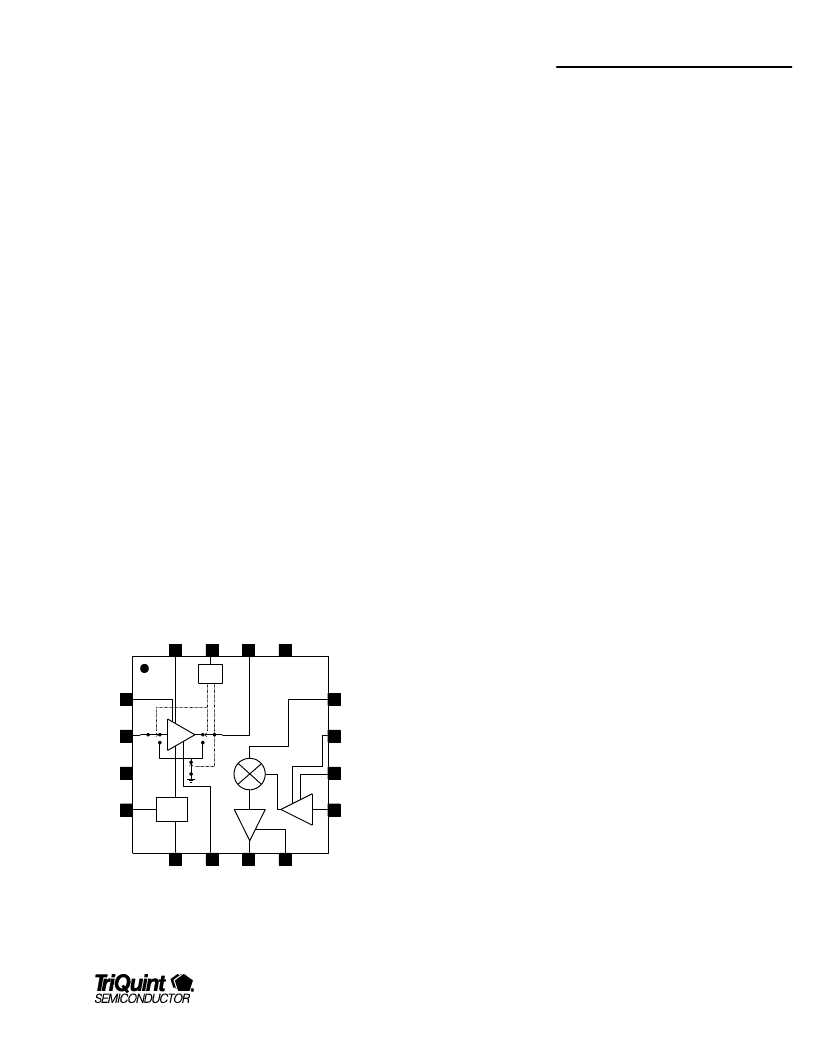- 您現(xiàn)在的位置:買賣IC網(wǎng) > PDF目錄382684 > TQ5135 Analog IC PDF資料下載
參數(shù)資料
| 型號: | TQ5135 |
| 英文描述: | Analog IC |
| 中文描述: | 模擬IC |
| 文件頁數(shù): | 9/22頁 |
| 文件大小: | 261K |
| 代理商: | TQ5135 |

TQ5135
Data Sheet
For additional information and latest specifications, see our website:
www.triquint.com
9
Pinout Description:
The TQ5135 is a complete front-end for a low band CDMA
handset receiver. It combines a high IP3 low noise amplifier,
a high intercept mxer, and an IF amplifier. The LNA uses an
off-chip matching network, which connects to the input at pin
2. The amplifier was designed so that the match for maximum
gain also gives very low noise figure. The LNA has two
modes, high gain and bypass. Pin 15 is the input to the gain
control logic, which drives the switch FETs. In the high gain
mode (pin 15=low), the LNA provides around 17dB of gain. In
the bypass mode (pin 15=high) it has a loss of about 2dB.
The LNA also provides several ways of setting gain and
intercept in the design phase. The LNA FET source is
brought out to Pin 16, where a small value of inductance to
ground can be added. The inductor can be discrete or simply
a small length of pc board trace. Several dB of adjustment is
possible. A bias resistor on pin 4 is used to set the LNA supply
current. A nomnal value of 2.7kohmis recommended, but it
can be increased for lower LNA Idd.
The LNA output signal is at Pin 14. It is a 50 ohmline and can
be connected directly to a SAW image filter. The image filter
output connects to the mxer input at Pin 12. The mxer
receives its LO via a buffer which amplifies the signal fromPin
9. The drain of buffer transistor is connected to Pin 10 where
it is connected to an external LO tuning inductor.
GND
GND
RF In
GND
LNA
Bias
MXR In
IF Out
GIC
GND
LO
In
GND/LNA
Gain
LNA Out
LO
Vdd
N/C
LNA Vdd
LNA
Mode
Mixer
IF Amp
LO Buffer
1
active
bias
logic
LNA
Figure 1. TQ5135 Block diagram
The IF signal fromthe mxer is fed to an amplifier. The IF
amplifier is an open drain type with output at Pin 7. An
external matching circuit is required to match the IF output to
a filter. The IF amplifier also has a GIC pin (Gain-Intercept-
Current). It is used to set the DC current and gain of the IF
stage.
Application Information:
Half IF Spur Rejection Considerations:
The TQ5135 does not contain a balanced mxer so Half-IF
spur rejection is completely set by the image filter. Thus we
do not recommend using an IF that is less than 2.5 times the
image filter.
Grounding:
With good layout techniques there should not be any stability
problems. Poor circuit board design can result in a circuit that
oscillates. Good grounding is especially important for the
TQ5135 since it uses an outboard LO tuning inductor that
provides one more potential ground loop path. One could
use the evaluation board as an example of proper layout
techniques.
It is important to position the LO tuning, GIC, and IF matching
components as close to the chip as possible. If the
components are far enough away they and their
corresponding pc board traces can act as quarter wave
resonators in the 5-10Ghz region. If both the IF and the LO
paths to ground resonate at the same frequency, oscillation
can result.
It is most important that the ground on the GIC bypass cap,
the ground on the LO tuning bypass capacitor, and the IF
shunt cap ground return back to the chip grounds with mnimal
inductance (Figure 2).
Also, improving the ground at the LO tuning inductor bypass
cap will increase circuit Q. Thus mxer drive is improved with
a resultant higher IP3. Improved ground here means mnimal
inductance between the chip ground pins and the other
ground return points.
相關(guān)PDF資料 |
PDF描述 |
|---|---|
| TQ5M34 | Analog IC |
| TQ8214 | Industrial Control IC |
| TQ8219 | Optoelectronic |
| TQ8223 | ATM/SONET Demultiplexer |
| TQ8224 | Industrial Control IC |
相關(guān)代理商/技術(shù)參數(shù) |
參數(shù)描述 |
|---|---|
| TQ5139 | 制造商:TRIQUINT 制造商全稱:TriQuint Semiconductor 功能描述:2.8V SiGe Dual-Mode CDMA Rx Receiver |
| TQ516-11A-AMINN500 | 功能描述:電線鑒定 VOID LABELS REORDER # AP1878 RoHS:否 制造商:TE Connectivity / Q-Cees 產(chǎn)品:Labels and Signs 類型: 材料:Vinyl 顏色:Blue 寬度:0.625 in 長度:1 in |
| TQ5622 | 制造商:TRIQUINT 制造商全稱:TriQuint Semiconductor 功能描述:3V PCS Receiver IC With Power- Down |
| TQ5631 | 功能描述:射頻放大器 CDMA High Band Mixer RoHS:否 制造商:Skyworks Solutions, Inc. 類型:Low Noise Amplifier 工作頻率:2.3 GHz to 2.8 GHz P1dB:18.5 dBm 輸出截獲點:37.5 dBm 功率增益類型:32 dB 噪聲系數(shù):0.85 dB 工作電源電壓:5 V 電源電流:125 mA 測試頻率:2.6 GHz 最大工作溫度:+ 85 C 安裝風(fēng)格:SMD/SMT 封裝 / 箱體:QFN-16 封裝:Reel |
| TQ5633 | 制造商:TRIQUINT 制造商全稱:TriQuint Semiconductor 功能描述:3V PCS Band CDMA RFA/Mixer IC(WIRELESS COMMUNICATIONS DIVISION) |
發(fā)布緊急采購,3分鐘左右您將得到回復(fù)。